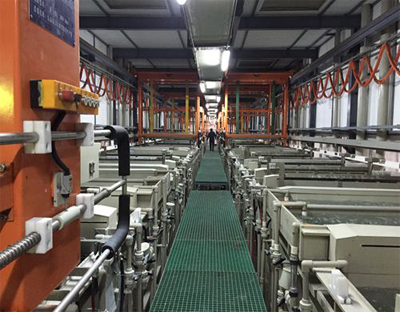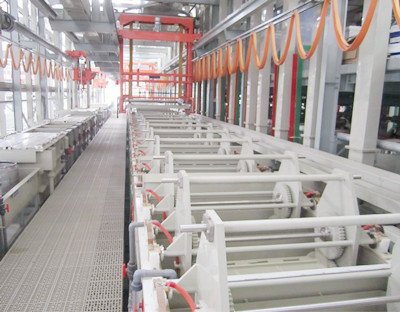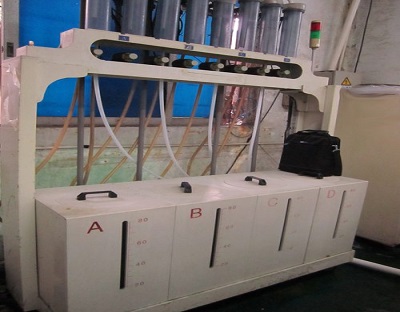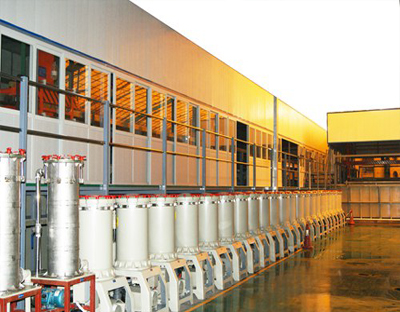How many types of Nickel plating?
The types of nickel plating solution mainly include sulfate type, chloride type, sulfamate type, citrate type, fluoroborate type, etc. The sulfate type (low chloride) is called watts (watt) nickel plating solution is most widely used in industry. The physical properties of nickel coatings obtained in several different nickel plating solutions are listed in table 2-3-45. Sulfamate type and fluoroborate type are suitable for thick nickel plating or electroforming. Citrate type is suitable for direct nickel plating on zinc die castings. The cost of these solutions is relatively high.
◆ ordinary nickel plating (dark plating)
1. Ordinary plating is also known as dark nickel process. According to the performance and application of plating solution, ordinary nickel plating can be divided into low concentration pre solution, ordinary plating solution, Watt solution and barrel plating solution.
Pre plating solution: the pre plating can ensure good adhesion between the coating and copper iron matrix and subsequent copper plating layer.
Ordinary bath: the bath has good conductivity, can be electroplated at lower temperature, saves energy and is convenient to use.
Watt bath: meet the electroplating of small parts, but the bath must have good conductivity and coverage.
2. Preparation method of plating solution
Calculate the required chemicals according to the volume, dissolve them in hot water, mix them in a container, add distilled water to dilute to the required volume, stand to the required volume, stand for clarification, introduce the plating solution into the plating tank by siphon method or filtration method, and then add the dissolved sodium dodecyl sulfate solution, stir evenly, sample and analyze. After adjustment and trial plating, it can be produced.
3. Anode for nickel plating
The purity of nickel anode material is the most important condition in electroplating. The content of nickel is more than 99%. Impure anode leads to bath pollution and deterioration of the physical properties of the coating. The suitable nickel anodes in nickel plating are as follows: 1 Carbon containing nickel anode, 2 Oxygen containing nickel anode, 3 Sulfur containing nickel anode.
◆ Bright nickel
Bright nickel plating has many advantages. It can not only save heavy polishing process, improve operating conditions, save electroplating and polishing materials, but also improve the hardness of the coating and facilitate automatic production. However, the bright nickel plating layer contains sulfur, has large internal stress and brittleness, and its corrosion resistance is not as good as that of dark nickel plating. In order to overcome these disadvantages, multi-layer nickel plating process can be adopted to make the coating mechanical The properties and corrosion resistance have been significantly improved.
◆ High sulfur nickel
The general content of high sulfur nickel is 0.12 ~ ~ 0.25%. This kind of nickel has higher electrochemical activity than copper, copper tin, dark nickel, bright nickel, semi bright nickel, chromium, etc. The high sulfur nickel coating is mainly used for the middle layer of the anti protection decorative composite coating of the steel and zinc alloy matrix. Its principle is that the sulfur content of the bright nickel in the upper layer is higher than that of the semi bright nickel in the lower layer, so that the potential difference between the two layers is 100 ~ ~ 140mv. In this way, the double-layer nickel changes from the longitudinal corrosion of the single-layer nickel to the transverse corrosion, forming the electrochemical protection of the steel matrix.
◆ Nickel seal
Nickel sealing is to add insoluble solid particles (SiO2, etc.) with a diameter of 0.01 ~ ~ 1um into the general bright nickel solution, and co deposit these particles with nickel to form a composite nickel coating with the help of appropriate co deposition accelerator. When a chromium layer is deposited on the surface of the composite nickel plating layer, because the solid particles on the surface of the composite nickel plating layer are not conductive, chromium cannot be deposited on the particle surface, so a large number of micropores are formed on the whole chromium plating layer, that is, a microporous chromium layer is formed. A large number of micropores on the surface can largely eliminate the huge internal stress in the ordinary chromium layer, thus reducing the stress corrosion of the coating. It is particularly important that a large number of micropores on the chromium layer expose a large area of the nickel layer under the chromium layer. Under the action of corrosive medium, chromium and nickel form a corrosion battery, the chromium layer is the cathode, and the nickel layer exposed at the micropores is the anode Corrosion, which changes the corrosion mode of large cathode and small anode, so that the corrosion current is almost dispersed on the whole nickel plating layer, so as to prevent a small number of large and deep corrosion grooves and pits directly penetrating the base metal, reduce the corrosion rate of the coating and develop laterally, so as to protect the base metal and significantly improve the corrosion resistance of the coating.
◆ Satin Nickel
Satin nickel is also called satin nickel. There is no essential difference between satin nickel and nickel sealing process. It has a satin like appearance. After plating, it will not flash like bright nickel plating and chromium plating. Therefore, human eyes will not feel tired after watching. It can be used as an anti glare coating to avoid light reflection. This kind of coating has been widely used on the surfaces of automotive mirrors, internal fixation parts of vehicles, medical and surgical instruments, machine tool parts, glasses frames and so on.
◆ High stress nickel
Adding an appropriate amount of additives to a specific nickel plating solution can obtain a nickel layer with high stress, which is easy to crack into microcracks. This nickel layer is called high stress nickel.
High stress nickel is another nickel layer of about 1um on the surface of bright nickel. Due to the large internal stress of high stress nickel, after 0.2 ~ ~ 0.3um ordinary chromium layer is plated on its surface as usual, a large number of microcracks are generated in the high stress nickel layer at the interaction between chromium layer and high stress nickel stress, resulting in uniform microcracks on the surface of chromium layer. Like the nickel seal, the chromium layer becomes micro discontinuous chromium, but the micro discontinuous chromium is obtained from high stress. Under the action of corrosive medium, these crack parts form countless micro batteries, so that the corrosion current is dispersed at the micro cracks, so as to significantly improve the corrosion resistance of the whole coating.
◆ Multi layer nickel plating
Multi layer nickel plating is to obtain two or three layers of nickel plating on the same substrate by selecting different bath components and process conditions. The purpose is to increase the corrosion resistance of the nickel layer without increasing the thickness of the nickel layer or reducing the nickel layer. The multi-layer Ni / Cr composite layers which are widely used in production are
Double layer nickel semi bright nickel / bright nickel / chromium
Three layer nickel semi bright nickel / high sulfur nickel / bright nickel / chromium
Semi bright nickel / bright nickel / nickel seal / chromium (microporous chromium)
Semi bright nickel / bright nickel / high stress nickel / chromium (microcrack chromium)
◆ Sulfamate nickel plating
The main advantage of sulfamate nickel plating is that the obtained plating layer has low stress and fast deposition speed, but the price is expensive. It is used for nickel plating before electroforming and printed circuit board gold plating.
◆ Citrate nickel plating
Citrate nickel plating process is mainly used for electroplating of zinc die castings. The main maintenance measures are: control the ratio of nickel sulfate to citrate at 1:1.1 ~ ~ 1.2, the temperature shall not be too high to prevent citrate decomposition, strictly control the pH value, and adopt impulse current (2 ~ 3A / DM2) for parts into the tank to ensure good adhesion. Citrate nickel plating is not widely used, and there are few successful manufacturers.
Leukoplakia Countermeasures
Cause of occurrence
The white spots of electroless nickel plating are caused by a kind of high carbon, which is produced in the process of heat treatment carburization and pickling before electroplating.
(1) Carbon (mainly Fe and C) on the surface layer of 1018 material after normal carburization
It can reach 0.8 ~ 1.2. The particles protruding in the coating are due to the incomplete cleaning of pretreatment, so that the particles on the surface of the workpiece fall into the plating solution. Due to the stirring effect in the plating process, these particles free in the plating solution are co deposited with nickel ions.
(2) The uncovered holes in the coating are mainly caused by excessive corrosion (surface decarburization) during pretreatment and pickling. The main component of acid washing solution in electroplating plant is HCl 1:1; H2SO4(98%)50 mL/L; The formula can be used for ordinary carbon steel, but the concentration is too high for high carbon steel. The higher the carbon content, the more intense the pickling reaction. After surface decarburization, it has a great influence on the conductivity of the workpiece and the adhesion of the coating. The holes in the coating are actually caused by the poor conductivity (or poor adhesion) of the high carbon part and the coating is difficult to cover.
Terms of settlement:
(1) The pretreatment cleaning process was improved and the ultrasonic cleaning method was adopted to make the particles with poor adhesion fall off in the cleaning.
(2) Filter the plating solution in time.
(3) Improve the pickling process: mainly reduce the concentration of pickling solution, add appropriate corrosion inhibitor and properly control the pickling time to avoid over corrosion.
By taking the above measures, the problem of electroplating white spots of the product has been fundamentally solved.






 Nov. 03, 2021
Nov. 03, 2021 





